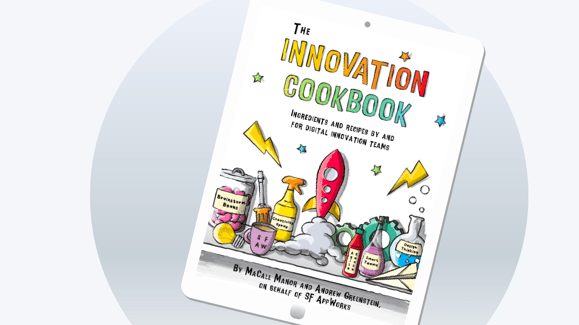Here at SF AppWorks, we’ve had the privilege of working alongside skilled innovation teams—teams that have inspired us to launch our own innovation services, complete with product ideation and development, rapid prototyping, and design sprints. In exploring new collaborative opportunities to apply the practices we’ve learned, we remember the people who have been influential in our leap to the other side—one such individual is Luke Chatelain, who at the time of our engagement was developing digital solutions at West Elm. Luke’s unique approach to ideation and delivery has earned him a colorful career and a resume studded with some killer product development stories. We sat down with Luke on The Innovation Cookbook to discuss his innovation methodology, highlights, and challenges.
“I've really been an individual who's interested in driving innovation and problem solving for my entire career.” -Luke Chatelain
Like many product leads, Luke has an unusual background; his Masters in biotechnology and biochemistry has proven an unlikely ally on his unexpected path in retail.
“A lot of the ideas that we learned and we discussed and talked about in my graduate program (and even in schooling) are things that I’ve carried throughout my entire career—from the biotech world, all the way into startups and agencies within New York, and ultimately [sort of] into the retail world, helping to try and drive innovation, disruption, and a strong understanding of how technology can actually solve not only problems of the business itself, but really solving pain points for customers, which is the most important part of my job.”
Luke operates by the scientific method. Many of his professional decisions have been based on the idea of creatively solving for a hypothesis, testing that hypothesis as quickly as possible, and using those findings to forge an (often unprecedented) path forward. For Luke, testing creative solutions can range from paper prototyping all the way through tangible, buildable prototypes or features that can be run with AB testing.
“I’ve always loved the way technology allowed people to solve problems, and I always loved the logical approach that science takes, of building upon one discovery after another until you get to a sort of ‘aha’ moment. I really think that sort of ends up being the core of a lot of innovation. It’s not a magic thought in a room with a bunch of people that you go out and spend tons of resources on to execute. It is oftentimes an incremental step-wise sort of program to get to a bigger moment. Oftentimes I would say that when you get to that bigger moment, you don't even realize you took a big step, because you've been taking these incremental movements the entire time.”
Andrew mentioned that an upside of the scientists’ viewpoint is that they don’t usually expect to get things right on the first try—a great lesson for anyone trying to solve a complicated problem. "Incrementality" can often translate to an overnight success... after ten years of hard work.
Prior to West Elm, Luke spent a lot of time working for agencies. A pivotal role in his career was at RGA, a large agency in New York, where he worked on the Nike account for Nike.com, building out different social and native applications.
“It was a very broad team that was working on site, products, and sort of subsets of things. That was where I really first, really got exposed to retail. One of the things that was really interesting about that was, our ability to bring things to light for consumers very quickly and understand the value that those might have.”
While working on the Nike skateboarding app (Nike SB), Luke recalls a time when he and members of his team went down to skateparks in New York City.
“...we just started showing it to kids and asking them what they would do with it, or ask them what it needed, or validate, look at what they were doing. And one of the biggest insights that came out of that was watching these skateboarders use their phones to record each other.”
Get a Free Copy of 'The Innovation Cookbook'

The project would evolve into a digital platform where skateboarders could upload and store their recordings on a platform where they could progress through various trick trees and advance their skill-levels skateboarders. Meanwhile, Luke was advancing his understanding of the connection between consumers and retail—namely that its scope was much wider than just transactional. He wanted to be nearer to how technology could support that.
“I really didn't understand why retail continued to go to agencies and startups. And I was also very interested in this idea of trying to help larger retailers solve a lot of these very down the middle technical problems that I was solving for these organizations. I went out on my own to start a small innovation and consulting (didn't really know what it was). I knew I wanted to do something for myself, and ended up doing a three month stint at West Elm helping them with a lot of mobile capabilities, and that just snowballed into a full-time role with the ownership of a full team and the ability of actually driving a true innovation vehicle within West Elm itself.”

Photo via Shutterstock
What with Luke’s extensive academic background in biology, we wondered why he didn’t immediately spring forward into the unfolding biotech landscape. He told us he did—after grad school he worked in biotechnology for a number of years.
“And to be honest with you, that's really where I cut my teeth on understanding the strategy behind software, the evolution of how software incrementally builds to solve problems. It was where I connected with users...At some point I really realized that I was much more interested in the technical concepts and how technology solves problems than I was in the bio component.”
At the time, Luke may have also needed a Phd to help affect the kind of change he wanted to.
“When I was sort of out in the field coming out of grad school, that wasn't really an opportunity that was there. So there was a big moment in my life where I actually, to be totally transparent with you, quit my job and drove across the country for three months and just sort of snowboarded and hung out, and it was fantastic. I came back to New York and reset my expectations and pivoted my career into something that was much more technology oriented.”
Andrew asked if Luke learned anything valuable in that time that really affected his career.
“[One of the things I learned during that experience was that] I had a really strong ability to work with and handle ambiguity, which is something I tend to look for in innovators. And I say that because I really took a leap of faith, and I did something I really had always wanted to do. I always wanted to go out. I was very passionate about traveling the country and I never had an opportunity to do it. It was a super scary, very unknown thing, and I went and worked through it, and I got to the other side and actually figured out what I wanted and [worked through all the insanity days to sort of achieve that with my next position]. So for me, it was really that idea that your life isn't set, this sort of bad statement of jump in the net will appear—a little bit of that. But for me it was more about working with unknowns and being able to handle those in a way that was very easy."
Rapid Prototyping at West Elm

Photo via Shutterstock
Luke returned from his travels re-inspired to help bridge a crucial gap recognized in product development at startups, agencies, and their corporate counterparts. Whereas startups and agencies took “a very ‘technology is our product’ methodology and mentality,” large companies and organizations were usually stuck in an outdated waterfall building style.
“For me personally, a lot of my thesis around going out on my own was to create a group of people or to help people learn about and educate themselves on how the product led methodology was actually being utilized by pure technology organizations to solve problems for their customers and their users. And when I ended up at West Elm, what I realized was that this was a perfect place to actually help work on and refine and help to drive that goal…”
He noted that West Elm is a part of a larger group, Williams Sonoma. Because it’s a part of a portfolio of smaller brands, it has the bandwidth to experiment with new and different concepts and approaches to innovation. For Luke, this meant an opportunity to drive and help educate people within the brand around how to actually execute innovative technology work—something he described as “build[ing] from both sides in.” He was fusing a marketing-led IT perspective with a product-led methodology—balancing between getting people to believe in the scientific method and rapid prototyping, building those prototypes, and actually putting them in front of users.
“...that was the goal—to bring that, fund that, and demonstrate the value and efficacy of being able to actually bring really interesting technology to life in a quick way, validate it through very rigorous testing and user research, and use that as the real impetus for driving value for the customers.”
Luke’s work was unveiling the difference between having an end target, and discovering an end target that resonates with its users at a much higher frequency.
“I think product is discovering what that end state is. It’s flipping the idea of how technology is built on its head. Instead of saying, ‘I want a loyalty program,’ it’s going out and figuring out what our customers actually want that would make them continue to come back to us and feel a connection with the brand.”
Startups have an ability to uncover and discover what their users want and need, and how they can provide that value through constant testing and iteration. Bringing that into a larger organization is a challenge, but Luke was able to demonstrate that crucial value at West Elm.
We asked if it was a hard sell, getting Luke’s management to buy into his vision.
Luke said he was fortunate enough to work with people who were already interested in making this shift to a more agile digital creation method, although they weren’t fully familiar with it at the time. He was thankful not only for the opportunity to be that driver of change, but also for the adequate runway to do so.
“I will always say that I'm super proud of the work we did at West Elm, simply because we very much built quality features and capabilities that drove actual KPIs, conversion, revenue per visitor, AOV, etc, and we did it in the ways that we talked about. And those ideas were the things that got exported out to some of the other brands and started to be adapted across the entire portfolio.”
What didn’t work (and then what did)
Tackling a customer service issue, Luke’s team was interested in sharpening the system involved in pulling relevant customer information for the representative assisting them. The idea was that, if the process could be expedited through a chatbot or other digital solution, customers could get help more quickly and representatives could be more efficient—everyone wins. But the initial project didn’t go as expected.
“While it did make our customer service people more efficient, it really was not a positive experience. They were trying to type in freeform and the AI wasn't intelligent enough to understand it...they would miss a prompt, they would want to skip a prompt, they didn't want to deal with it.”
 Photo via Shutterstock
Photo via ShutterstockIf at first you don’t succeed….reframe the problem?
Despite the initial resistance, Luke and his team discovered that many customers actually wanted to use chat for design services and obtaining more information about products.
“The great, sort of pivot that we made there was that that dovetailed with a pretty large push internally for West Elm for promoting our free design capabilities and services, which were mainly an in-store capability.”
They took the chatbot experience and removed a lot of automated components, aka, made it more human. Now, it would directly connect some of their design service representatives with customers, so they could answer basic questions and assist in a more personalized way.
Nearly every experience is one you can learn from, especially in product development. Luke admitted that at first, the team likely took on too much software development proprietarily, which they also quickly pivoted by picking up a vendor to speed up implementation, which “really unlocked a ton of value for [west elm] and was a very easy lift,” getting them from concept to in-production usage within only a few weeks. By the way, I wonder who that vendor was 🧐.
This sort of successful meeting of a previously unknown need or desire is the bread and butter of innovation that CEOs and product developers are constantly trying to nail down. In Luke’s case, the effort resulted in trackable KPIs, and increased conversions and revenue per visitor. It also would have an amplified effect in the pandemic climate to come.
“If you go on westelm.com right now—at least in January of 2021, you'll see a prompt on the site after a little bit of time that says 'do you want to speak with a design service representative?' And what that is is the technology we built.”



COMMENTS